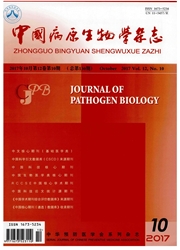

 中文摘要:
中文摘要:
目的分析和预测华支睾吸虫囊蚴全长cDNA质粒文库中编号为cs091c06的糖基转移酶基因EST序列结构和功能特征及其编码蛋白的理化性质,预测该基因的生物学意义和应用前景。方法利用NCBI网站和ExPaSy等生物信息学在线分析工具和Vector NTI suite等软件包,分析华支睾吸虫囊蚴全长cDNA质粒文库中cs091c06的EST序列及编码蛋白的理化性质、结构与功能特征。结果 BLASTx工具分析该EST序列是糖基转移酶的同源基因,序列全长为1 402bp,其完整的编码框为37~1 011bp,编码325个氨基酸。Target P和Signal P软件预测该编码氨基酸前30个氨基酸是分泌信号肽,蛋白的理化性质较稳定。蛋白质一级结构扫描发现两个糖基转移酶的保守功能区分别位于67~178aa和69~253aa,且在该基因的N端发现明显的蛋白质糖基化位点,分别位于76~79aa和190~193aa。在该基因的氨基酸序列中,共发现8个B细胞表位和6个T细胞表位。RT-PCR结果显示,该基因在华支睾吸虫成虫阶段高表达,囊蚴和虫卵阶段低表达。结论华支睾吸虫糖基转移酶基因与多个物种同源,编码蛋白可能是华支睾吸虫重要的虫体分泌排泄抗原成分;阶段特异性表达特征提示该基因很可能参与华支睾吸虫重要虫源蛋白糖基化过程,可作为华支睾吸虫病疫苗候选分子和药物靶标。
 英文摘要:
英文摘要:
Objectives To predict the structural and functional characteristics of cs091c06 glucosyltransferase from a full-length cDNA plasmid library for Clonorchis sinensis and to bioinformatically analyze the physical and chemical properties of the protein it codes for.A recombinant gene was constructed and the level of transcription was examined in different life stages of C.sinensis.The biological significance of the gene and its prospective use are discussed Methods Analytical tools provided by NCBI(http://www.ncbi.nlm.nih.gov/) and ExPaSy(http://www.expasy.org/) and bioinformatics software such as the Vector NTI suite were used to identify an EST clone(NO.cs091c06) from the full-length cDNA plasmid library for C.sinensis.Its coding regions were analyzed along with the physico-chemical properties and structural and functional characteristics of the protein it codes for.Results EST was predicted to be a homologue of glucosyltransferase with a complete sequence 1,402 bp in length.The complete coding region was 37-1011 bp in length and coded for 325 amino acids.The protein contained a secretory signal peptide of 30 amino acid residues at the N terminus with stable physico-chemical properties.The protein consisted of two spatially independent domains,with a conserved domain at(67-178) and(69-253).The gene had an apparent protein glycosyl site at the N terminus located at(76-79) and(190-193).The gene's amino acids included eight linear B-cell epitopes and six linear T-cell epitopes.RT-PCR indicated that the level of transcription was greater in adult worms and lower in metacercariae and eggs of C.sinensis.Conclusion C.sinensis glucosyltransferase is homologous with glucosyltransferase from other species and is probably an excretory-secretory antigenic component.Characteristics of stage-specific expression indicated that the gene is probably involved in the important process of glycosylation by C.sinensis and may be a promising candidate for vaccines and drugs targeting clonorchiasis.
 关于余新炳:
关于余新炳:
 同期刊论文项目
同期刊论文项目
 同项目期刊论文
同项目期刊论文
 Serological diagnosis of clonorchiasis: using a recombinant propeptide of cathepsin L proteinase fro
Serological diagnosis of clonorchiasis: using a recombinant propeptide of cathepsin L proteinase fro Molecular identification, immunolocalization, and characterization of Clonorchis sinensis calmodulin
Molecular identification, immunolocalization, and characterization of Clonorchis sinensis calmodulin Molecular and biochemical characterizations of three fructose-1,6-bisphosphate aldolases from Clonor
Molecular and biochemical characterizations of three fructose-1,6-bisphosphate aldolases from Clonor Characterization of the secreted cathepsin B cysteine proteases family of the carcinogenic liver flu
Characterization of the secreted cathepsin B cysteine proteases family of the carcinogenic liver flu Oral delivery of Bacillus subtilis spore expressing enolase of Clonorchis sinensis in rat model: ind
Oral delivery of Bacillus subtilis spore expressing enolase of Clonorchis sinensis in rat model: ind Advanced enzymology, expression profile and immune response of Clonorchis sinensis hexokinase show i
Advanced enzymology, expression profile and immune response of Clonorchis sinensis hexokinase show i Clonorchis sinensis acetoacetyl-CoA thiolase: identification and characterization of its potential r
Clonorchis sinensis acetoacetyl-CoA thiolase: identification and characterization of its potential r Identification and characterization of Clonorchis sinensis cathepsin B proteases in the pathogenesis
Identification and characterization of Clonorchis sinensis cathepsin B proteases in the pathogenesis Identification, immunolocalization, and immunological characterization of nitric oxide synthase-inte
Identification, immunolocalization, and immunological characterization of nitric oxide synthase-inte Proteomic identification of potential Clonorchis sinensis excretory/secretory products capable of bi
Proteomic identification of potential Clonorchis sinensis excretory/secretory products capable of bi Identification, immunolocalization, and characterization analyses of an exopeptidase of papain super
Identification, immunolocalization, and characterization analyses of an exopeptidase of papain super Sequence Analysis and Molecular Characterization of Clonorchis sinensis Hexokinase, an Unusual Trime
Sequence Analysis and Molecular Characterization of Clonorchis sinensis Hexokinase, an Unusual Trime Biochemical and immunological characterization of annexin B30 from Clonorchis sinensis excretory/sec
Biochemical and immunological characterization of annexin B30 from Clonorchis sinensis excretory/sec Systemic and local mucosal immune responses induced by orally delivered Bacillus subtilis spore expr
Systemic and local mucosal immune responses induced by orally delivered Bacillus subtilis spore expr Stage-specific expression, immunolocalization of Clonorchis sinensis lysophospholipase and its poten
Stage-specific expression, immunolocalization of Clonorchis sinensis lysophospholipase and its poten The Carcinogenic Liver Fluke, Clonorchis sinensis: New Assembly, Reannotation and Analysis of the Ge
The Carcinogenic Liver Fluke, Clonorchis sinensis: New Assembly, Reannotation and Analysis of the Ge Identification and Characterization of Paramyosin from Cyst Wall of Metacercariae Implicated Protect
Identification and Characterization of Paramyosin from Cyst Wall of Metacercariae Implicated Protect Molecular identification, immunolocalization, and characterization of Clonorchis sinensis triosephos
Molecular identification, immunolocalization, and characterization of Clonorchis sinensis triosephos CsRNASET2 is an important component of Clonorchis sinensis responsible for eliciting Th2 immune resp
CsRNASET2 is an important component of Clonorchis sinensis responsible for eliciting Th2 immune resp Molecular characterization and expression of Rab7 from Clonorchis sinensis and its potential role in
Molecular characterization and expression of Rab7 from Clonorchis sinensis and its potential role in Surface display of Clonorchis sinensis enolase on Bacillus subtilis spores potentializes an oral vac
Surface display of Clonorchis sinensis enolase on Bacillus subtilis spores potentializes an oral vac 期刊信息
期刊信息
